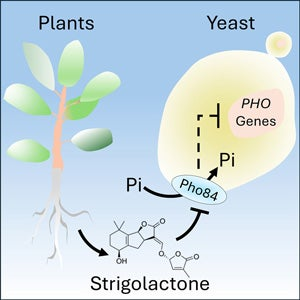Researchers at the University of Toronto have cracked the code of plant-to-fungi communication.
Using baker's yeast, the researchers discovered that the plant hormone strigolactone (SL) activates fungal genes and proteins associated with phosphate metabolism, a system that is key to growth.
This insight into how fungi respond to chemical signals at the molecular level - detailed in a new study published in the journal Molecular Cell - could lead to new strategies for cultivating hardier crops and combatting disease-causing fungi.

Shelley Lumba (supplied image)
"As we begin to understand how plants and fungi communicate, we will better understand the complexities of the soil ecosystem, leading to healthier crops and improving our approach to biodiversity," says Shelley Lumba, lead author and assistant professor in the department of cell and systems biology in U of T's Faculty of Arts & Science.
In the soil, plant roots engage with fungi in a silent molecular "language" to direct their structure. When plants release SLs, they signal fungi to attach to their roots, providing phosphates - the fuel plants need to grow, and a major component of most fertilizers - in exchange for carbon.
For the study, Lumba and her fellow researchers investigated why and how fungi respond to SLs. Eighty per cent of plants rely on this symbiotic relationship, and enhancing this interaction with beneficial fungi could yield hardier crops, reduce fertilizer use and minimize phosphate runoff into waterways.

For the study, Lumba and her fellow researchers investigated why and how fungi respond to the plant hormone strigolactone. Illustration: Bradley et al., 2024, Molecular Cell 84, 1-17.
In other cases, disease-causing fungi can exploit chemical cues to infect crops, sometimes wiping out entire harvests. Understanding this chemical language could also help block such pathogens.
The researchers treated baker's yeast with SLs and observed which genes were turned off and on in response. They found that this chemical signal increased the expression of genes labelled "PHO" that are related to phosphate metabolism. Further analysis showed that SLs function through Pho84, a protein on the surface of yeast that monitors phosphate levels, activating a cascade of other proteins in the phosphate pathway.
The researchers determined that plants release SLs when starved for phosphate, signalling the yeast to change its phosphate uptake.
They found the phosphate response to the SL signal holds true not only for domesticated fungi such as baker's yeast but also for wild fungi - specifically the detrimental wheat blight Fusarium graminearum and the beneficial symbiotic fungus Serendipita indica.
"Gene expression as an output from chemical treatment is key to this approach - it identifies the effect of the SL response on fungal growth." says Lumba.
Scientists can use this straightforward method to systematically identify plant-derived small molecules that communicate with fungi. Enhancing the interaction with beneficial fungi could lead to advances in agriculture and mitigate pollution and food insecurity.
"The potential impact of this research can improve the lives of so many," says Lumba. "It's about healthy soil for a healthy planet."
With files from A&S News













